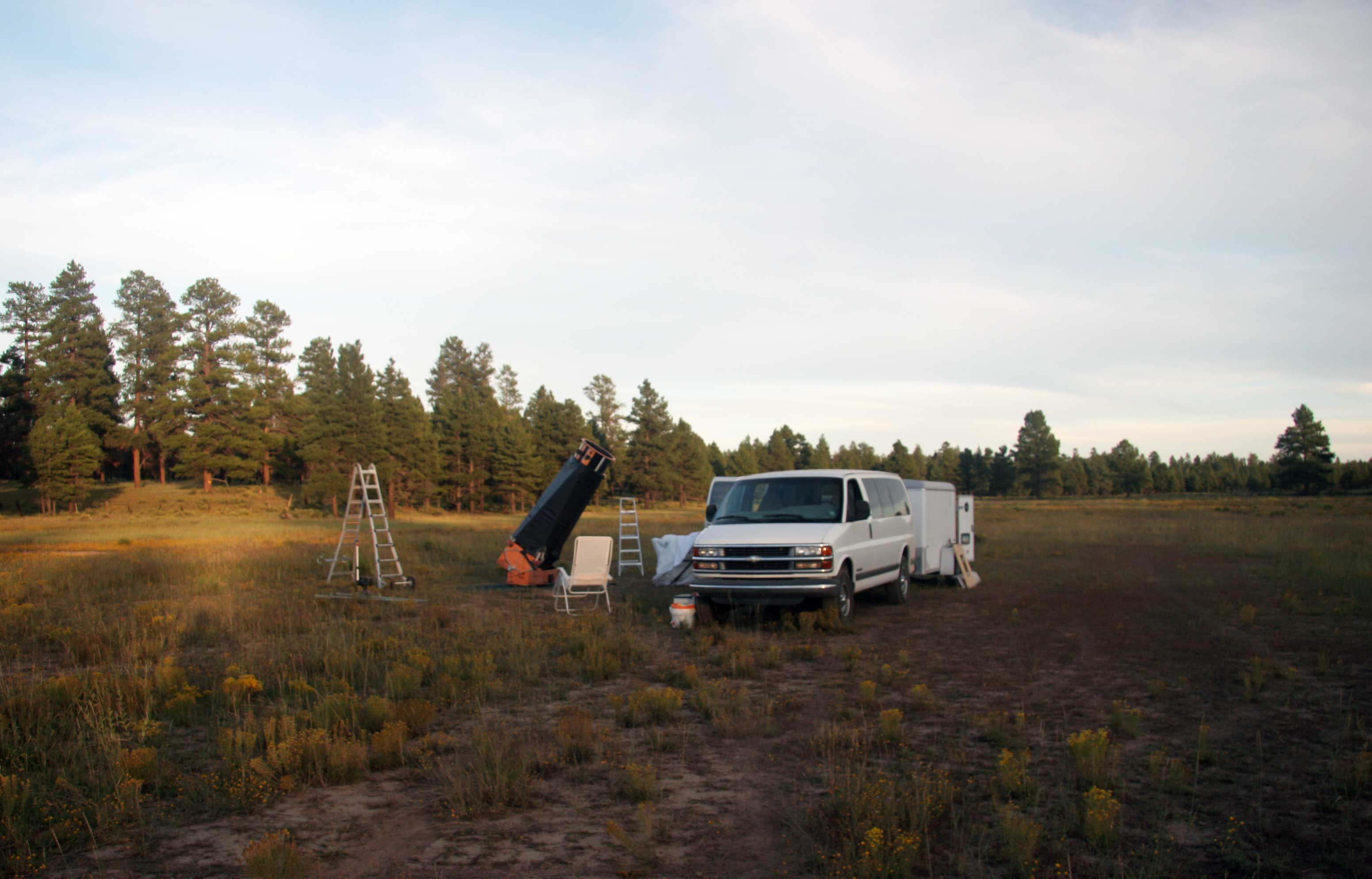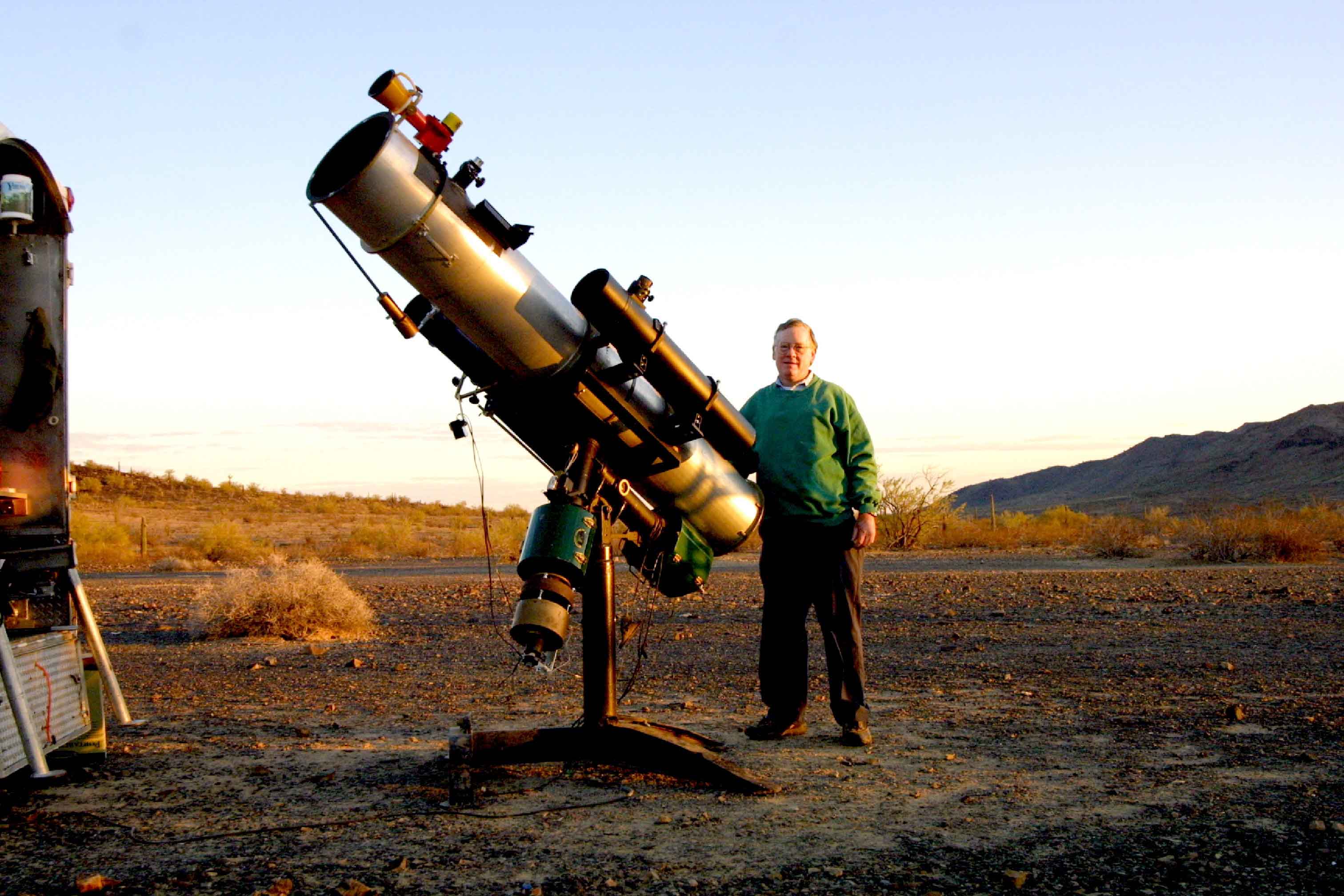

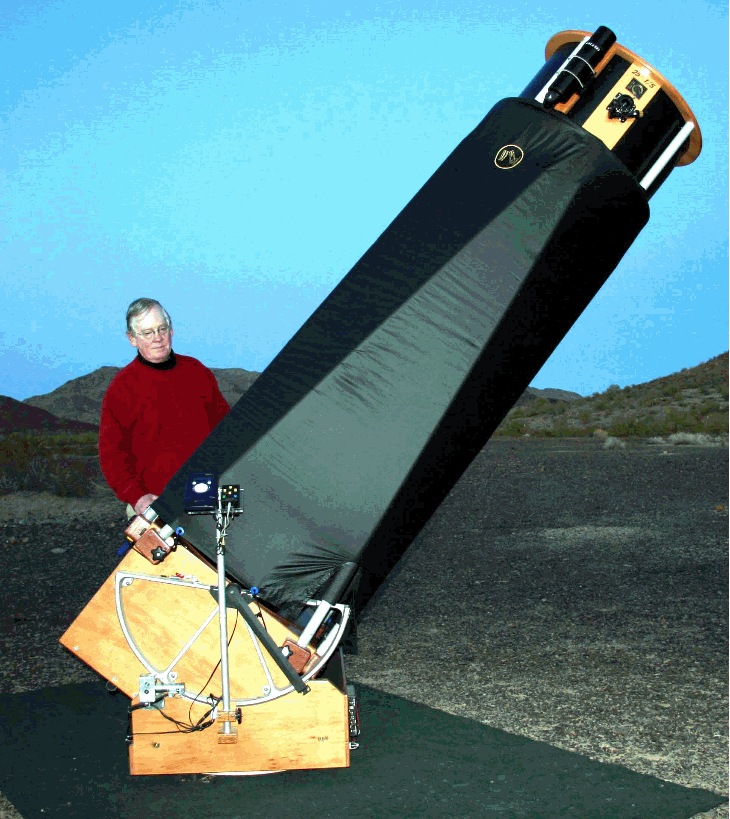
I'm an amateur astronomer. These are my two current telescopes. The top one is my 12.5" Newtonian Reflector that I have been observing with now for almost 50 years. The mirror was ground by the legendary Alika Herring and was purchased from Cave Optics in 1960. My father had a machine shop and we spent my senior year in high school building this from junk laying around his shop. The mounting is a German Equatorial with motorized drives and gadgets all over. The telescope now weighs over 1100 lbs because I keep adding things to it. (such as the 6" Russian-made Maksutov-Newtonian shown on the near side). I also added digital setting circles to it not long ago. The whole thing comes out the back of a custom-made trailer on a winch-like mechanism that I will need to describe in a series of pictures. I'll do this when I get time to work on this web page. It takes about 20 minutes to set up and about 30 minutes to pack up. No lifting or heavy effort is involved. This photo was taken by Bill Van Orden in December, 2002 during a cold sunset at a dark-sky site in western Arizona. The sky was clearing and I had just put on 3 layers. As soon as the photo was done, I got into a parka and turned on the electric socks. Another great Saturday night trolling the cosmos while listening to Bruckner symphonies. You are looking at a chap in paradise.
The second is my newer 25" from Obsession Telescopes. The Dobsonian mount was built in Wisconsin by Obsession. The mirror was ground by Galaxy Optics in Colorado Springs. The motorized slewing and tracking system was built by StellarCat in Sierra Vista, Arizona. The computer holding the database and GoTo instructions was built by Argo-Navis in Australia. After aligning this big sucker on 2 known stars, you just enter an object name on the computer, push a button on a wireless hand pad, and get out of the way. It slews around rapidly, slows down as it gets near the object, and sends out a little "ding" sound when done. You climb a ladder and there it is. Amazing.
The base the 25" is a box that weighs about 180 lbs. It comes out the back of a trailer on wheelchair ramps with wheelbarrow arms and wheels that are temporarily attached. Eight 8' poles are attached to form a truss. The upper assembly is carried up a big ladder and secured to the top. A black nylon shroud goes around the truss to keep stray light out. The observing ladder was a challenge because it has to be big, sturdy, and heavy. I bought a huge, sturdy adder at Hope Depot and attached wheels and fold-out arms and push it around like a wheelbarrow. Easy.
Visual observation of the universe is something I never tire of. Few people really know what can be seen from a dark-sky site with telescopes like the ones shown above. With the exception of the fainter arms of spiral galaxies, I have never seen a photograph that captures the stunning nature of the cosmos like views through my telescope. Photos ALL show stars as blobs. Imagine a view of a globular cluster with its thousands of stars, each a little mathematical point of light! With the introduction of nebular filters, the gas clouds and planetary nebulae display a breathtaking beauty that photos just do not capture. The brighter arms of the spiral galaxies are stunning in the big 25". Considering the effort (and luck) it takes to accumulate the equipment, develop the skills for visual observing, get to a good site, and stay up all night after a grueling week of work, it is no wonder that so few have experienced all this. Once hooked though, there is no going back.
My visual survey of the universe is now being done mostly by the 25". Here is an excerpt of a report I wrote for my fellow members of the Arizona Observing list serve.:
"Observing Report from Griffin Ranch May 30, 2011:
Last Monday night I went east of Phoenix to an area near the EVAC Griffin Ranch site to specifically take a look at the goings-on toward the core of our galaxy. The night was calm and incredibly clear with a SQM-L zenith reading of 21.67 around 10 pm. I chased galaxies on my observing list while the Milky Way above the eastern horizon rolled up toward the meridian. When Antares finally culminated, I put in a new 21 mm Ethos eyepiece on the 25” Obsession and began a journey into the spiral arm of stars, dust, and gas between us and the galactic core. Little did I know that it would yield one of the most emotionally overwhelming observing encounter in the 55 years I have been scouring the deep night sky.
After marveling at M4 where loose star chains give the impression of a great unwinding caused by some disrupting influence, I slew east toward the dark interstellar clouds and faint steely gray obscuration that starts just to the east. Tiny globular cluster N 6144 is the last peep at something distant. It looks to me like its eastern side is dimmed by the encroaching murk and the field stars largely vanish as I scan eastward. Chasing the meridian along its intersection down the slanting length of westward moving Scorpius, I make repeated diversions to admire clusters and even get a fascinating high power view of the intricately detailed Bug Nebula. The atmosphere is so steady tonight I can stoke up the power even at objects this low.
Around 2 am, the galactic core reaches the meridian and I throw off all pretense of observing catalogued objects systematically. I pull off the drive clutches, grab the truss and just sweep slowly, field by field with the Ethos 21. I am startled to see an immense glowing veil of background stars appear, each a little infinitesimal point of light. They are so numerous that there is hardly space between them. It isn’t just the amorphous glow typical of this region that you get in a smaller scope or in a brighter sky; it is a glow made up of uncountable discrete points of light that I have never before seen as such. Against this background of blazing pinpoints, the brighter, closer stars form a separate and noticeably less numerous population. But the astounding thing is the dark stringers, elongated patches, and discrete blobs of jet-black obscuring clouds of all sizes and shapes silhouetted against this luminous curtain. We’ve all seen the big ones in binoculars, but here is telescopic field after field of stringy jet black filaments, swirls, and patches sharply delineated against the stellar multitude--all spangled with pinpoint foreground stars of various brightness and subtle colors. The intricate boundaries and shapes of the dark clouds are beyond comprehension and certainly beyond verbal description. Just when you get your breath from one view, the next one moves in with even more spectacular, infinite detail. It goes on and on, field after field. The number of stars seen in one gulp continually astonishes. Then, obscuring strands appear that have that steely gray sheen indicating they are reflecting starlight or actually glowing in H alpha. They are especially noticeable when they appear in contrast with or grade into jet black counterparts in the same field. For nearly an hour, I can only marvel, gasp, and exult over what I am seeing. I put in a 13mm Ethos and find even more detail in these dark networks! Unbelievable! I have swept these areas a hundred times with my old 12.5” and even twice with the 25”, but never with eyepieces like these or on a night like this. This is all new and glorious. For an interval, I feel like I am on top of the Mount Everest of amateur astronomy. Even of human existence. How many human eyes have seen sights like this? Who even imagines it is possible? I think this might even choke up a person without a soul. All the effort to acquire the biggest transportable optics, to bleed bucks for the best eyepieces, to get everything working, and to opportunistically travel to distant dark sky locations when conditions are right is here yielding a payoff beyond what dreams are made of.
M7 moves into the field and I see it in palpable 3D in front of more distant innumerable stars seen around and through this brilliant cluster. The uniquely ring-shaped dark cloud Barnard 294 floats into a 13mm Ethos field with the background stars shining in the middle hole with undiminished intensity. What vagaries of history led to this shape? Peculiar star cluster NGC 6451 with its big vacant lane running down the middle appears. The ambient background stars are absent in this band, and it has a barely visible gray sheen relative to some of the inky black clouds in the vicinity. This all gives a visceral impression that the lane is not an absence of stars but rather obscuration by a thin dark filament floating somewhere between here and there. And so it goes.
At length, the climax along the meridian is over. The low-lying galactic center is now rapidly sinking into the southwest and more long-lived Milky Way skies are rotating into view. I do the usual peeks at M8, the Trifid, and M17. All are mind-boggling views, but I am exhausted and still reeling from the ecstatic stellar drenching just passed. It is coming up on 3 am, the sky is already brightening, and I am too old to continue on, great night that it is. I wake up around noon to wind and clouds. Still seared and shell-shocked by cosmic views of unsurpassed splendor, the afternoon drive back through Globe and into the Phoenix Valley is bewildering,
I have been searching deep photos of these regions on the web tonight and am astonished at the inadequacy of how they represent what you can actually see at higher magnification. While the photos certainly indicate the star density, the stars are little blebs and clots typically touching one another. Not pretty.. The dark clouds loose much of their definition and the small delicate filaments are lost in the overexposed clutter. It is altogether different and vastly more spectacular in reality. Seeing is believing. I now burn to repeat the experience at an even darker, higher site and under even better skies. North Rim?"
Here is how you lug a 25" around:
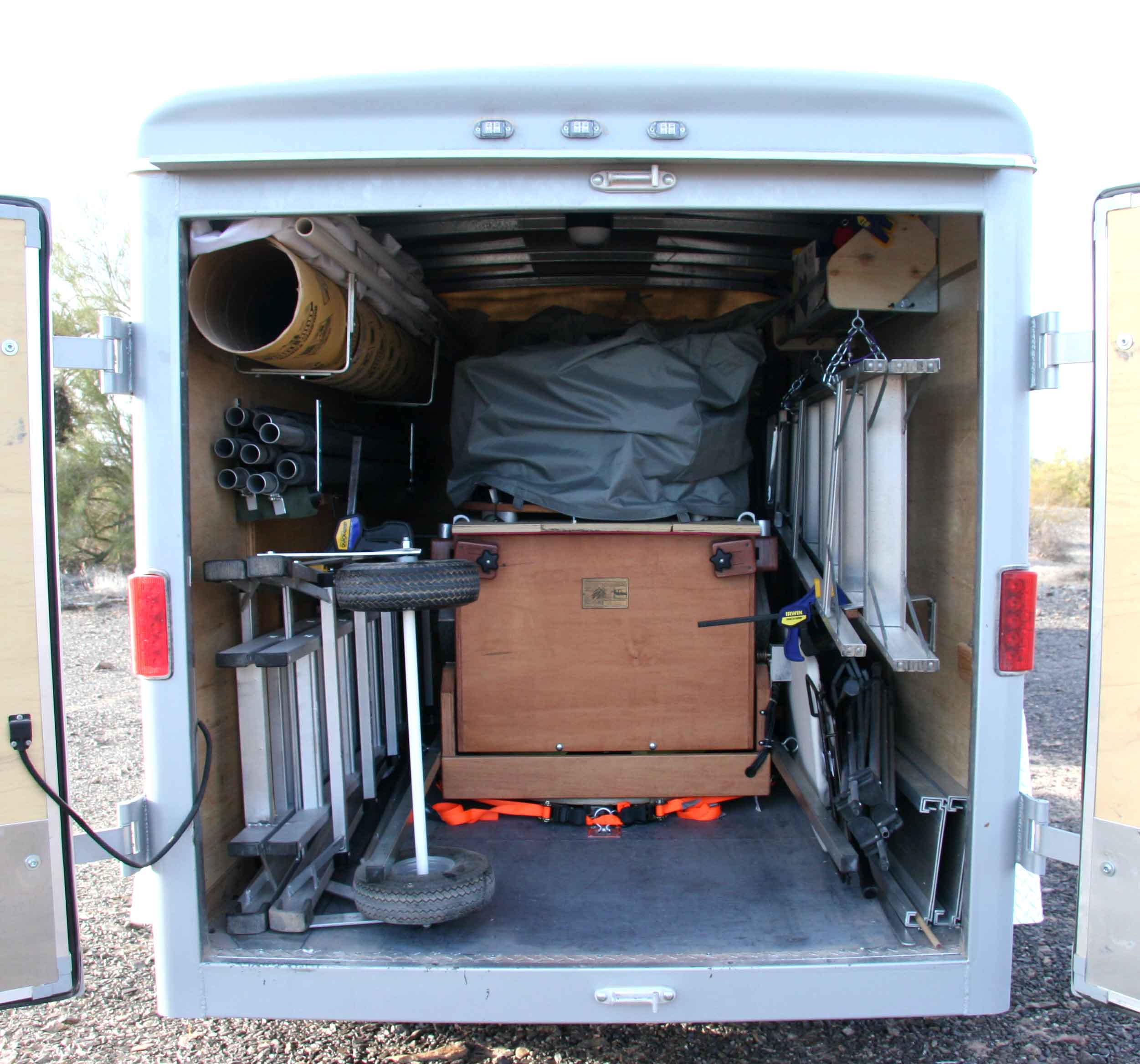
Here is the setup in the winter in the desert:
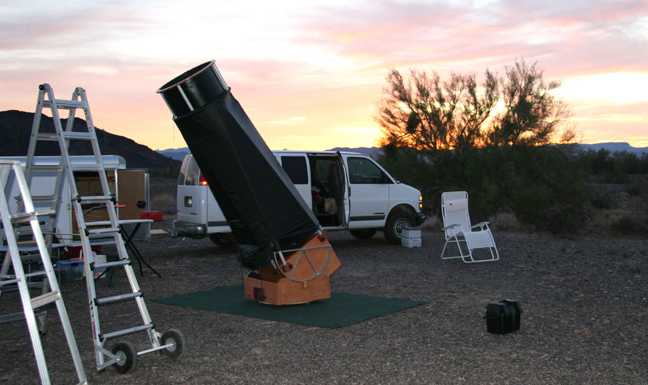
In the Arizona high country in the summer:
